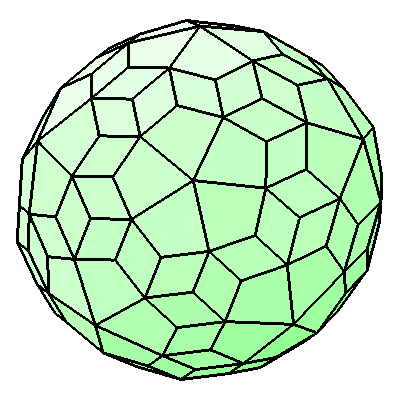Regularity is an important
concept in polyhedra. Well known are the 'regular' or 'Platonic'
polyhedra which are considered as completely regular. Archimedic and Catalan
polyhedra are half-regular polyhedra.
Now is the question how
regularity is determined. Who or what defines which polyhedron is
regular and which not. For answering of this question the following
five rules are frequently used. If all five rules are applicable to a
polyhedron, than that polyhedron is completely regular.
1. The faces are regular
polyhedrons
2. The faces are congruent
(identical in shape)
3. The vertexes are congruent
4. The dihedral angles are congruent
5. The polyhedron is convex
The Platonic polyhedra apply to
all these five rules and are thus completely regular. Archimedic
polyhedra apply to rules 1, 3 and 5 and are therefore half-regular.
The cuboctahedron and icosidodecahedron also apply to rule number 4
(but remains half-regular). Catalan polyhedra apply to rules 2, 4 and
5. The rhombic polyhedra apply to rules 2, 3, 4 and 5. Catalan and
rhombic polyhedra are therefore also half-regular.
The five rules are quite
limited to determine how regular a polyhedron is. For example the
polyhedron shown below: a rhombic deltoïd pentacontahectahedron. This
polyhedron is completely irregular according to the rules above: the
faces are no regular polyhedra, the faces are not equal, the vertexes
are not congruent, and the dihedral angles also differs. The only
thing you can say is that the polyhedron is convex. However, this
polyhedron seems to have some kind of 'regularity'

To gain more insight in
the exact regularity of a polyhedron, I would like to introduce
the concept 'regularity index'. This index is a relation between
the number of edges of a polyhedron (as a size for its dimension)
and the number of repetitions within the polyhedron. More
information about this regularity index can be found on the next
tab.